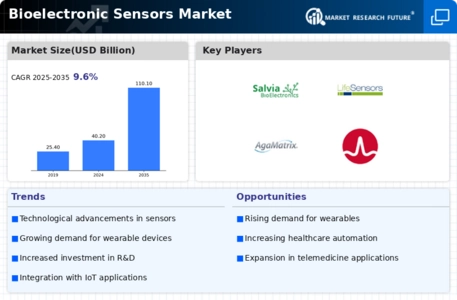Increasing Focus on Personalized Medicine
The shift towards personalized medicine is reshaping the Global Bioelectronic Sensors Market Industry. As healthcare moves away from a one-size-fits-all approach, bioelectronic sensors are becoming integral in tailoring treatments to individual patient needs. These sensors provide critical data that can inform personalized treatment plans, enhancing efficacy and patient satisfaction. The growing emphasis on personalized healthcare solutions is expected to drive market growth, with the industry projected to reach 40.2 USD Billion by 2024. This trend reflects a broader movement towards precision medicine, where bioelectronic sensors play a crucial role in monitoring and adjusting therapies based on real-time patient data.
Rising Demand for Wearable Health Devices
The increasing prevalence of chronic diseases and the growing emphasis on preventive healthcare are driving the demand for wearable health devices. These devices, which often incorporate bioelectronic sensors, enable continuous monitoring of vital signs and health metrics. The Global Bioelectronic Sensors Market Industry is witnessing a surge in innovations aimed at enhancing user experience and accuracy. For instance, the integration of bioelectronic sensors in smartwatches allows for real-time health tracking, which is particularly appealing to health-conscious consumers. As the market is projected to reach 40.2 USD Billion in 2024, the trend towards wearable technology is likely to continue shaping the industry.
Growing Investment in Healthcare Technology
The Global Bioelectronic Sensors Market Industry is experiencing a surge in investment as stakeholders recognize the potential of bioelectronic technologies in transforming healthcare delivery. Governments and private entities are increasingly funding research and development initiatives aimed at advancing bioelectronic sensor applications. This influx of capital is likely to accelerate innovation and commercialization of new products. With a projected compound annual growth rate of 9.6% from 2025 to 2035, the market is poised for substantial growth. Investments in healthcare technology not only enhance patient outcomes but also contribute to the overall efficiency of healthcare systems, thereby driving demand for bioelectronic sensors.
Technological Advancements in Sensor Technology
Technological advancements in sensor technology are significantly influencing the Global Bioelectronic Sensors Market Industry. Innovations in materials science and microfabrication techniques have led to the development of more sensitive and accurate bioelectronic sensors. These advancements facilitate the miniaturization of sensors, making them suitable for a wider range of applications, including diagnostics and therapeutic monitoring. As a result, the market is expected to expand, with projections indicating a growth to 110.1 USD Billion by 2035. The continuous evolution of sensor technology not only enhances performance but also reduces costs, making bioelectronic sensors more accessible to healthcare providers and consumers alike.
Regulatory Support for Bioelectronic Innovations
Regulatory support is becoming increasingly vital for the advancement of the Global Bioelectronic Sensors Market Industry. Governments are recognizing the importance of bioelectronic technologies in improving healthcare outcomes and are establishing frameworks to facilitate their development and approval. This regulatory backing not only fosters innovation but also instills confidence among investors and manufacturers. As the market evolves, supportive regulations are likely to streamline the approval process for new bioelectronic sensors, thereby accelerating their entry into the market. This environment of regulatory encouragement is expected to contribute to the projected growth of the industry, with a compound annual growth rate of 9.6% anticipated from 2025 to 2035.















Leave a Comment